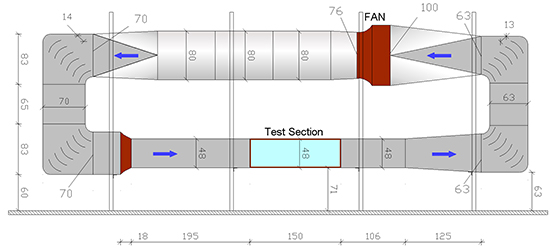The Research and Educational Wind Tunnel (R&E-WT) at the Department of Civil Engineering is a closed-circuit wind tunnel (Göttinger type). The air is circulated through a vertical installed duct system as illustrated in the figure below. The main working part is the lower stretch of the wind tunnel. Here, the airflow approaches from the left to the test section. The part upstream of the test section is called the “fetch”, where roughness elements such as small blocks and thin spires allow for generating a turbulent boundary-layer flow similar to the wind flow in the earth's atmosphere. In basic configuration the flow is smooth, i.e. of low turbulence intensity (< 1%).

Principle sketch and main dimensions of the Research and Educational Wind Tunnel.
(all measures in [cm] - basic wind tunnel configuration)
The R&E-WT can be adopted for different types of tests. Apart from the flow characteristic (uniform smooth or turbulent boundary-layer) the test section can be used in closed and open configuration. The below listed dimension and flow properties refer to closed test section without any flow modulation.
| Property/dimension |
Value
|
| Test section inner cross-section |
47 x 47cm
|
| Test section length |
150cm
|
| Maximum airspeed in basic configuration |
38m/s
|
| Minimum turbulence intensity Iu |
< 1%
|
Even though of small dimensions the R&E-WT allows for the simulation of a turbulent flow similar to the turbulent boundary layer flow in the earth's atmosphere, namely the natural wind. The comprehensive setup is ideal for comparative studies between physical and numerical simulation of wind flow. The latter, i.e. the numerical simulation, addresses the field of Computational Wind Engineering (CWE), which is one of the future research areas within the CEAero group.

a) Flow study on a floor-mounted cube to compare with results from CFD. b) Flow visualisation of vortex shedding from a generic ice covered cable model. c) Open test section configuration for load measurements on a high-rise building model and for flow visualisation.
The compact setup of the flow processing unit and test section is ideal for comparative studies between physical and numerical simulation of wind flow and loads. Apart from validation studies the wind tunnel is used for different test purposes. The main three test types are briefly described below.
Validation Tests for Numerical Simulation: At CEAero, one research aspect is the application of Computational Fluid Dynamics (CFD) on structural and architectural wind engineering issues. The related studies focus on the characteristic of the simulated turbulent boundary-layer flow, the near flow field around a floor-mounted cube and the flow induced time-variant pressure fluctuation on the cube surface. (closed test section)
Aerodynamic Coefficients of Structural Elements: The aerodynamic load coefficients on scaled or full-size structural elements are determined in smooth or turbulent flow. The latter flow condition is usually generated by a uniform grid mounted near the entrance of the test section. (closed test section)
Building Aerodynamics & Urban Environments: The closed test section can be replaced with a turn-table floor forming hence an open test section, which is less sensitive to blockage effects and allows for easy access to the model area. This setup is used to investigate the flow field around building structures, wind load effects on buildings and the impact of urban form on human wind comfort. (open test section)
Furthermore, the wind tunnel is an integrative part of course 11331 “Experimental Structural Mechanics” (stochastic wind load on a high-rise building) and 11994 “Engineering on Urban Scale” (wind comfort in urban areas). A special course “Introduction to Wind Tunnel Testing in Civil Engineering” is given as preparation for projects on BSc, MSc and PhD level.